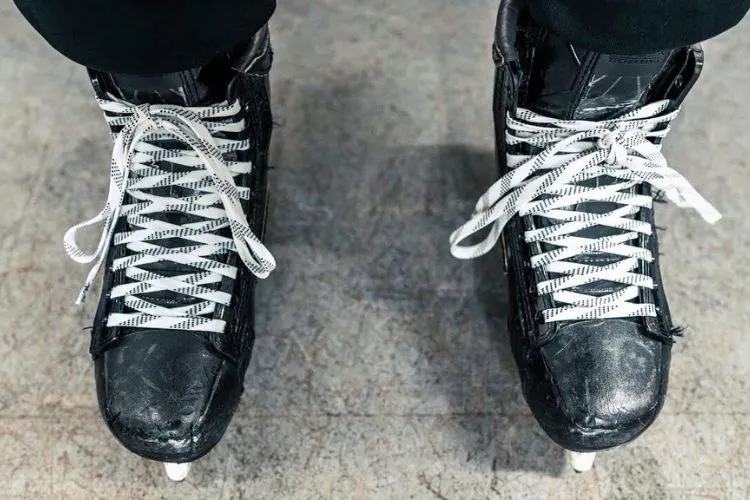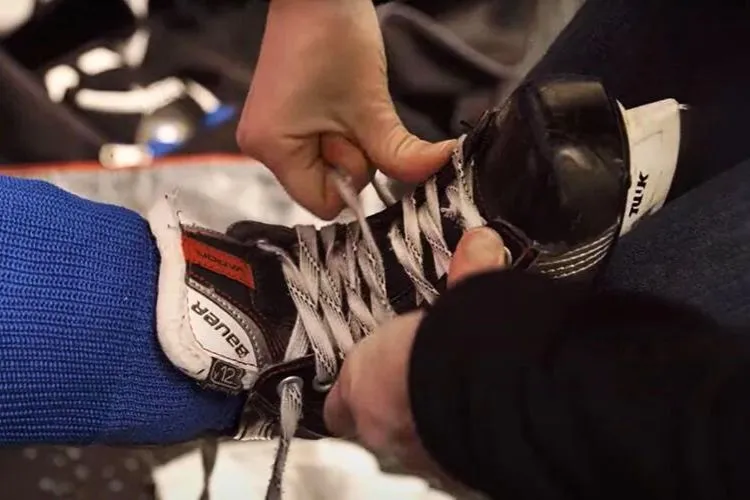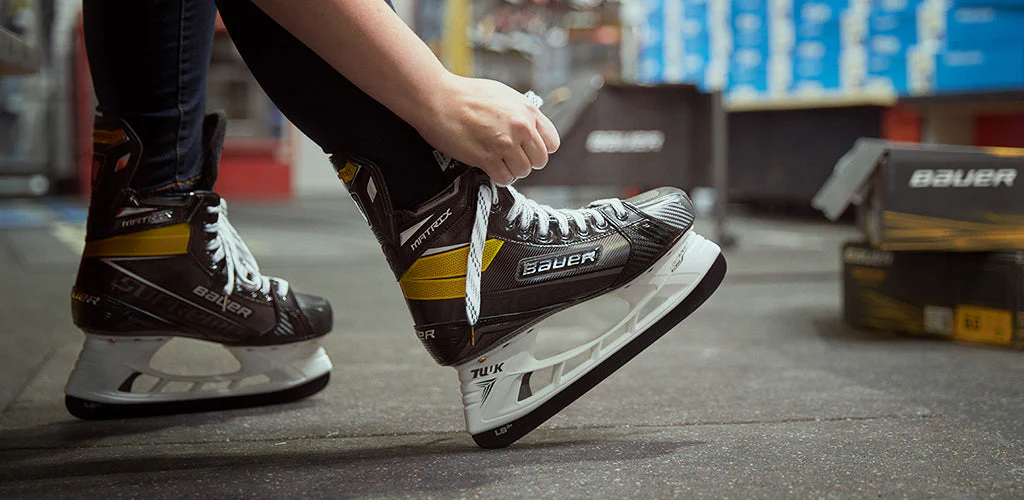Hockey skates are a crucial piece of gear for any player. They impact your performance, comfort, and the risk of injury. Getting the lacing right is more than just a ritual; it’s a necessity.
This guide will walk you through how to lace hockey skates effectively, ensuring you’re as ready for the ice as possible.

Objectives of Proper Lacing
The main goals when lacing skates include enhancing foot stability, optimizing comfort, and preventing injuries.
Proper lacing techniques ensure your skates work with your feet, not against them, allowing for improved control and agility on the ice.
Necessary Tools and Materials
Before you start, ensure you have the right tools. These include your hockey skates, suitable hockey laces (either waxed or non-waxed), and optionally, a lacing hook or puller for those who struggle with grip or have larger fingers.
Preparing to Lace Your Skates
Choosing the right skate and fit is crucial. Skates should be professionally fitted if possible. At home, you can check for fit by ensuring there’s a snug feel without any pinching.

Inspect skates and laces for wear or damage before each lacing, and select the right type and length of laces.
Incorrectly sized laces can either be too short, making proper lacing difficult, or too long, presenting a tripping hazard.
How to Lace Hockey Skates?
Threading the Lace
Begin at the toe and work towards the top, threading the lace through the bottom eyelets. Aim for an even starting point to ensure balance and even tension.
The Base Cross Lace
Crossing the laces correctly is important. They should cross in a straight and even manner, avoiding any twisting. This forms the foundation of a good lacing job.
The Tightening Technique
Tighten the laces segment by segment, moving from toe to top. This ensures uniform pressure and support across the entire foot and ankle. It should be firm but not overly tight to maintain circulation.
Locking the Ankles
For those needing more ankle support, additional techniques such as a lace lock or surgeon’s knot can be beneficial. This step is crucial for players who prefer a tighter fit around the ankles for better stability.
Finishing Up
Secure the laces with a sturdy knot that won’t come undone easily. Excess lace should be tucked away to prevent accidents on the ice.
Post-Lacing Checklist
After lacing your hockey skates, it’s crucial to ensure they fit correctly, not just when standing but also in motion. To do this, walk around in your skates on a safe surface.
Pay attention to how they feel on your feet. Are they snug but not overly tight? Do they offer enough support around the ankles?

As you move, the skates should feel like an extension of your feet, without any pinching or slipping. If anything feels off, take the time to re-adjust the laces. This step might seem small, but it’s vital for comfort and performance on the ice.
Since how the skates feel during a game can differ from how they feel off the ice, making sure they’re correctly adjusted beforehand can prevent discomfort and improve your play.
Maintenance and Care for Hockey Skates and Laces
To ensure your hockey skates and laces stay in prime condition, establish a maintenance routine. Frequently check your laces for fraying, stretching, or any damage.
Worn-out laces can impact your performance and safety on the ice, so replace them at the first sign of wear.

For storage, avoid damp or overly dry environments that could damage both the skates and laces. Use skate guards to preserve the blades and maintain their sharpness.
Properly storing your skates also involves keeping them in a shape that prevents the material from deforming, ensuring they remain comfortable and functional. This care regime guarantees your skates and laces last longer and perform better.
Pro Tips
Experiment with different lacing techniques to find what works best for your foot shape and playing needs. Minor adjustments during a game can make a significant difference in comfort and performance.
Common Mistakes to Avoid
One critical mistake in maintaining hockey skates is the improper tension of the laces. Over-tightening your skates can restrict blood flow to your feet, leading to numbness and decreased performance.
Conversely, under-tightening provides insufficient support, increasing the risk of ankle injuries and affecting your stability on the ice.
Furthermore, neglecting to monitor the wear and tear on both laces and skates can lead to sudden malfunctions during play.
Regular inspections for fraying laces, dull blades, or damaged boot material are essential. Addressing these issues early prevents unexpected problems, ensuring optimal performance and prolonging the life of your hockey gear.
You may also read: How to Pick the Right Hockey Skate Hollow?
Frequently Asked Questions (FAQs)
How often should I replace my hockey skate laces?
Laces should be replaced at the first sign of fraying or when they no longer hold tension well. Regular inspections will help you gauge the right time.
What are the benefits of waxed versus non-waxed laces?
Waxed laces hold tension better and are less likely to loosen, providing a more consistent fit. Non-waxed laces are more traditional and may offer a slightly more comfortable feel.
Can improper lacing affect my skating performance?
Yes, improper lacing can lead to a lack of support and stability, potentially affecting your speed, agility, and comfort on the ice.
What should I do if my skates feel too tight or too loose after lacing?
Re-lace your skates, paying special attention to tightening techniques. Ensure even pressure and comfort throughout the foot.
Are there different lacing techniques for different levels of hockey play?
While the basics of lacing are similar, players may adjust their lacing technique based on personal preference or to address specific needs related to their level of play and position.
Conclusion
Lacing hockey skates properly is an essential skill that impacts your on-ice performance. With practice, the right technique can become second nature, ensuring you’re both comfortable and supported every time you hit the ice.
Lacing hockey skates correctly is a fundamental skill that affects your performance and safety on the ice. By following this guide, you’ll be well on your way to mastering this essential task, ensuring your skates are as ready for the game as you are.

Matthew James is a passionate skater who wanted to create a platform to share his love for skating with others. With a vision to create a vibrant community of skaters, he aims to provide a space where skaters of all levels can connect, learn, and grow together.
